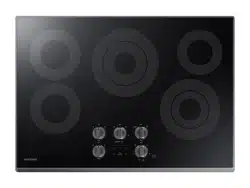Documents: Go to download!
- Owner's manual - (English, French, Spanish)
- Before you start
- Operations
- Maintenance
- Troubleshooting
Table of contents
Owner's Guide Electric Cooktop
Before you start
About surface cooking
CAUTION - BEFORE COOKING
- Do not use the glass cooktop surface as a cutting board.
- Do not place or store items that can melt or catch fire on the glass cooktop, even when it is not being used.
- Turn the surface units on only after placing cookware on them.
- Do not store heavy items above the cooktop surface. They could fall and damage it.
CAUTION - DURING COOKING
- Do not place aluminum foil or plastic items such as salt and pepper shakers, spoon holders, or plastic wrappings on the cooktop when it is in use.
- Make sure the correct surface unit is turned on.
- Never cook directly on the glass. Always use cookware.
- Always place the pan in the center of the surface unit you are cooking on.
- Never leave surface units unattended while using a high heat setting. Boilovers cause smoking and greasy spillovers that may catch on fire.
- Turn the surface units off before removing cookware.
- Do not use plastic wrap to cover food. Plastic may melt onto the surface and be very difficult to remove.
CAUTION - AFTER COOKING
- Do not touch the surface units until they have cooled down.
- The surface may be still be hot and burns may occur if you touch the glass surface before it has cooled down sufficiently.
- Immediately clean spills on the cooking area to prevent a tough cleaning chore later.
- If cabinet storage is located directly above the cooking surface, make sure that the items in it are infrequently used and can be safely stored in an area subjected to heat. Temperatures may be unsafe for items such as volatile liquids, cleaners, or aerosol sprays.
About the radiant surface elements
The temperature rises gradually and evenly. As the temperature rises, the radiant element will glow red. To maintain the selected setting, the element will cycle on and off. The heating element retains enough heat to provide a uniform and consistent heat during the off cycle. For efficient cooking, turn off the element several minutes before cooking is complete. This will allow residual heat to complete the cooking process.
NOTE: Radiant elements have a limiter that allows the element to cycle ON and OFF, even at the HI setting. This helps to prevent damage to the ceramic cooktop. Cycling at the HI setting is normal and can occur if the cookware is too small for the radiant element or if the cookware bottom is not flat.
CAUTION: If the cooktop is installed above an oven, do not use the cooktop while the oven’s Self-cleaning function is on.
Location of the surface elements and controls
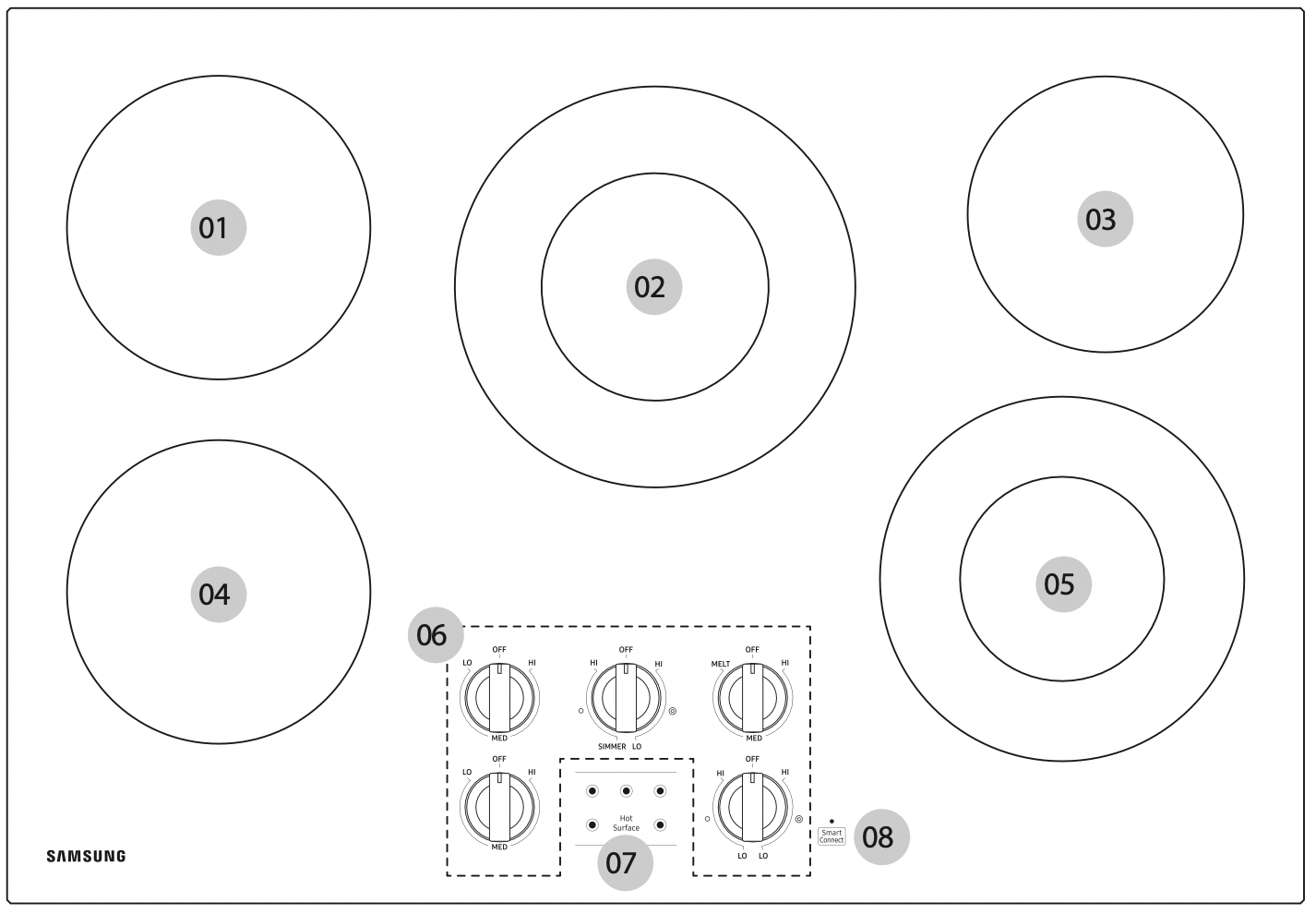
- Left Rear (7”, 1500 W)
- Center (6”/9”, 3300 W)
- Right Rear (6”, 1200 W)
- Left Front (7”, 1500 W)
- Right Front (5”/8”, 2000 W)
- Control Knob
- Hot surface indicator
- Smart Connect button
Knob lighting
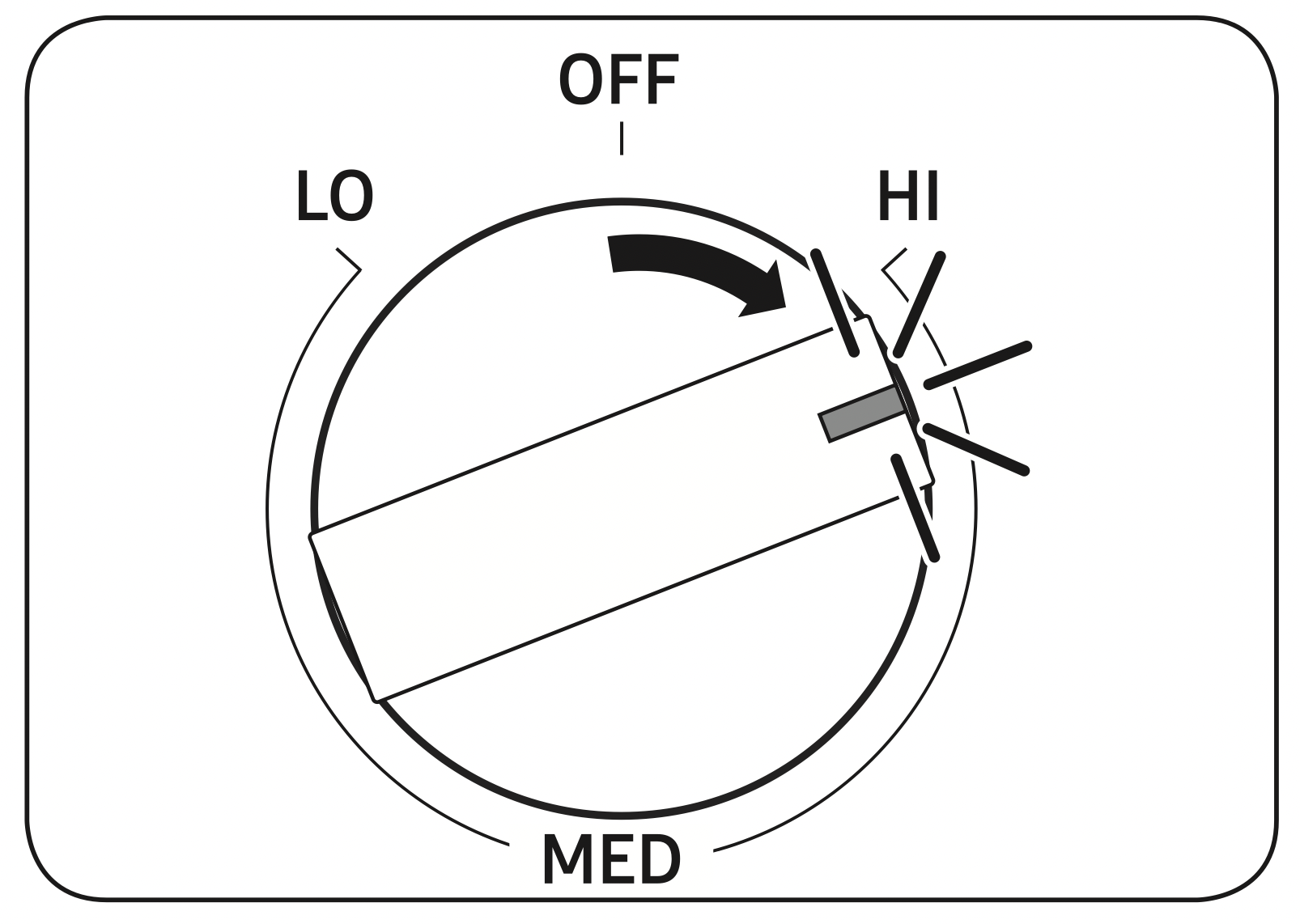
Press and turn the knob to a desired setting. The indicator turns on and confirms the selected setting.
Hot surface indicator
- Comes on when the unit is turned on or hot to the touch.
- Stays on even after the unit is turned off.
- The hot surface indicator turns off only when the cooking zone has cooled down to approximately 150 °F.
Cooking areas
- The cooking areas on your cooktop are identified by permanent circles on the glass cooking surface. For the most efficient cooking, fit the pan size to the element size.
- Pans should not extend more than ½˝ to 1˝ beyond the cooking area.
- When a control is turned on, you can see a glow through the glass cooking surface. The element will cycle on and off to maintain the preset heat setting, even at high settings.
- For more information on selecting proper types of cookware, refer to the section “Using the proper cookware”.
Initial cleaning
Wipe the ceramic glass surface with a damp cloth and ceramic cooktop glass cleaner.
WARNING: Do not use caustic or abrasive cleaners. You can damage the surface.
Operations
How to set the appliance for surface cooking
CAUTION
- The surface elements may be hot even when off and burns can occur. Do not touch the surface elements until they have cooled down sufficiently.
- At high or medium-high settings, never leave food unattended. Boilovers cause smoking and greasy spillovers may catch on fire.
- Be sure you turn the control knob to OFF when you finish cooking.
Single surface unit control knob (left rear, left front, right rear)
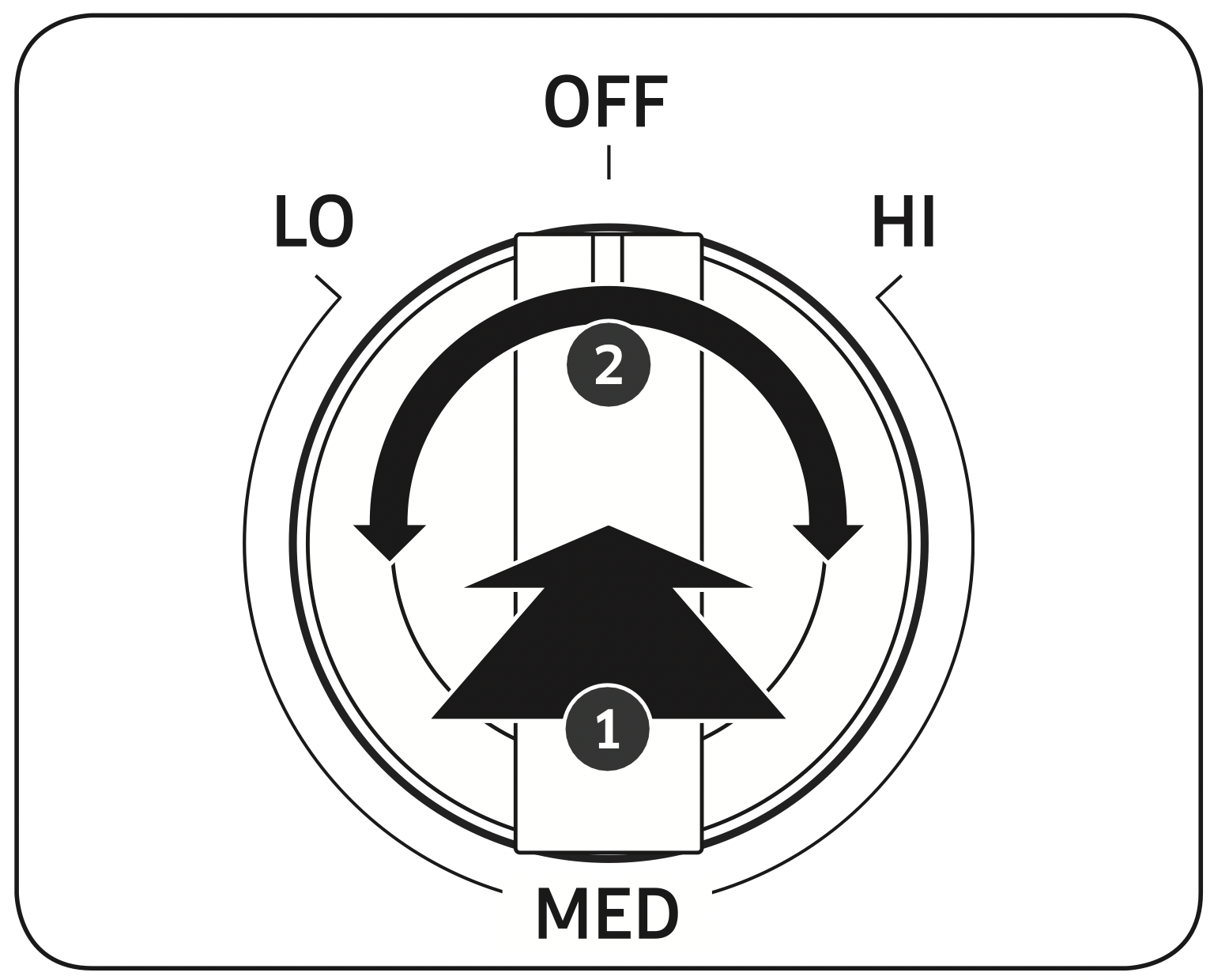
- Push the knob in.
- Turn in either direction to the setting you want.
- At both the Off and High settings, the knob clicks into position.
Dual surface unit control knob (center, right front)
The dual surface unit features an inner and outer element. You can select 1 or 2 elements (Single or Dual) depending on the size of the pot or pan you are using. [  ] indicates the single power zone, and [
] indicates the single power zone, and [  ] indicates dual power.
] indicates dual power.
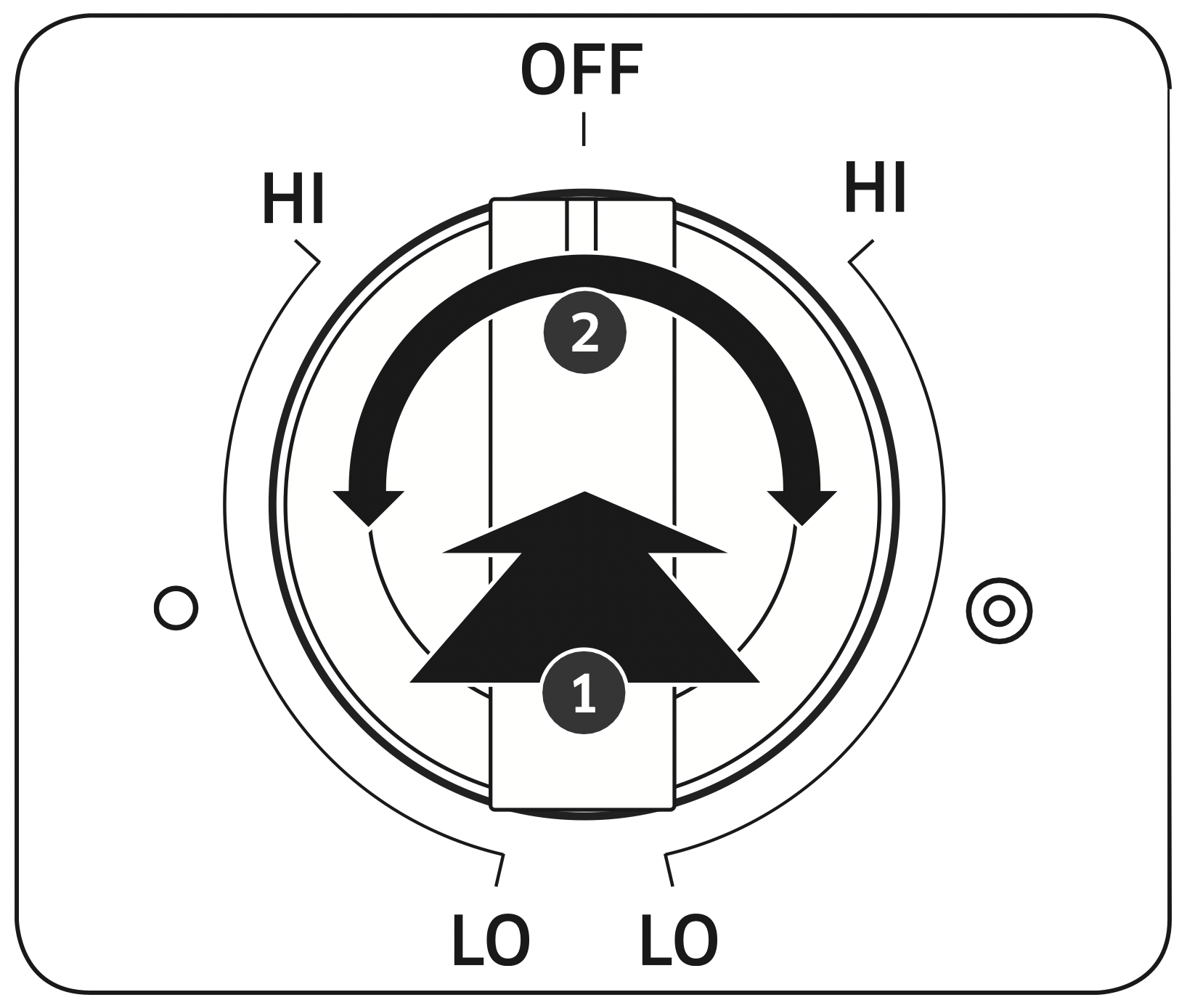
- Push the knob in.
- Turn in either direction to the setting you want.
To use the single surface unit, turn the control knob to the [ ] single element setting.
] single element setting.
To use the Dual surface unit, turn the control knob to the [ ] dual element setting.
] dual element setting.
NOTE: If you remove the knobs for cleaning, make sure to re-attach them in the correct orientation. (Refer to the illustrations on the previous page.)
CAUTION
- Please note: The operation of a control knob may not synchronize with the actual operation of the radiant element if there is a problem with the cooktop.
- The area on the knob between the high and off settings is not appropriate for cooking.
Recommended settings
The power levels in the table below are guidelines. The power settings required for various cooking methods depend on a number of variables, including the quality of the cookware being used and the type and amount of food being cooked.
|
SETTING |
TYPE OF COOKING |
|---|---|
|
HIGH |
|
|
MEDIUM HIGH |
|
|
MEDIUM |
|
|
MEDIUM LOW |
|
|
LOW |
|
NOTE
- The power settings indicated in the table above are provided only as guidelines for your reference.
- You will need to adjust the power settings according to the cookware you are using and the food you are cooking.
Using the proper cookware
Using the right cookware can prevent many problems, such as uneven cooking or extended cooking times. Using the proper pots and pans will reduce cooking times and cook food more evenly.
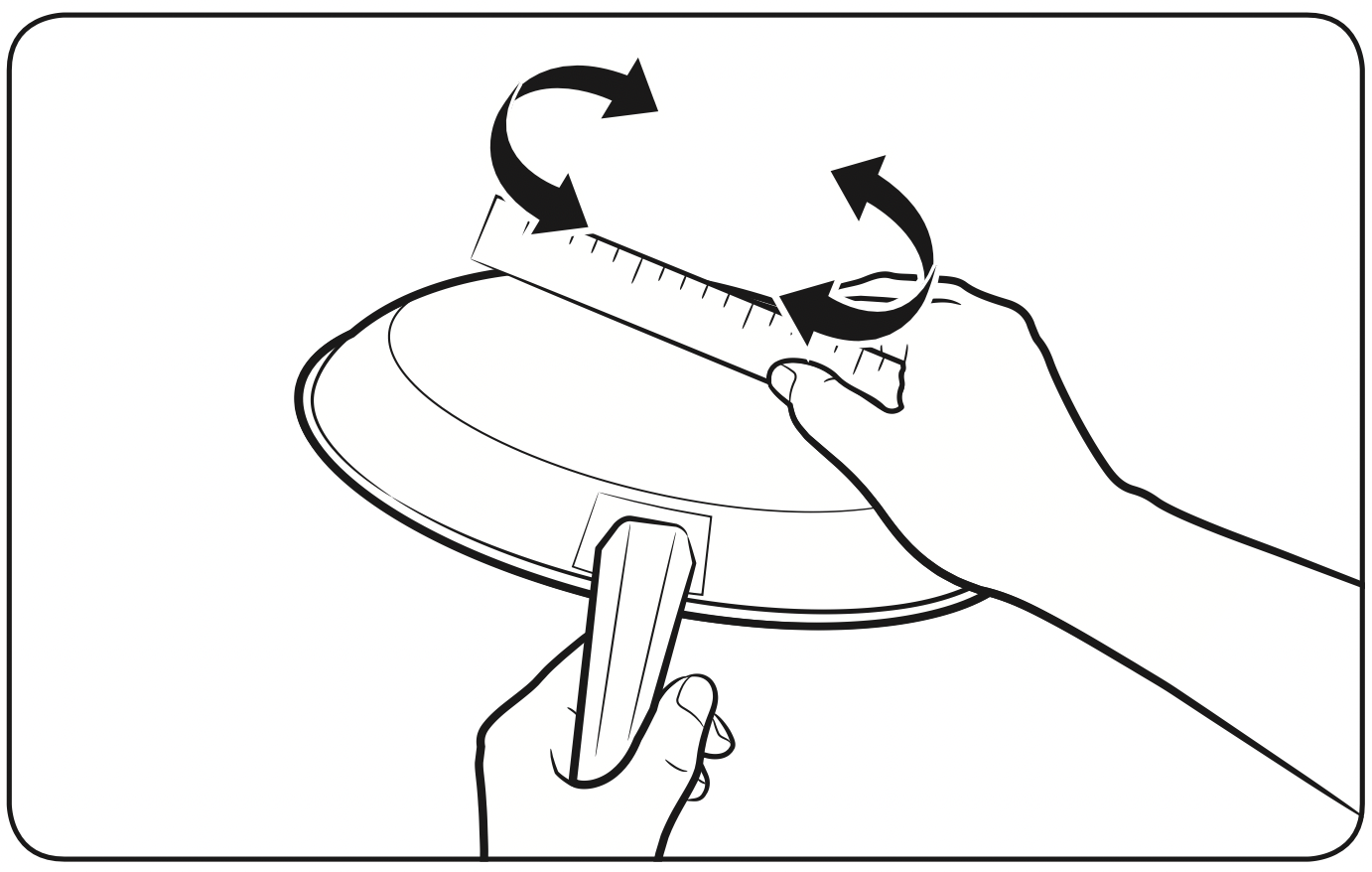
Check for flatness by rotating a ruler across the bottom of the cookware.
|
CORRECT |
INCORRECT |
|---|---|
|
Flat bottom and straight sides.
Always match pot diameter to element surface diameter. |
Curved and warped pan bottoms.
Pan overhangs element by more than one-half inch.
Pan is smaller than element.
Heavy handle tilts pan. |
Choosing the proper cookware
What your cookware is made of determines how evenly and quickly heat is transferred from the surface element to the pan bottom.
- ALUMINUM - Excellent heat conductor. Some types of food will cause the aluminum to darken. (Anodized aluminum cookware resists staining & pitting.). If aluminum pans are slid across the ceramic cooktop, they may leave metal marks that resemble scratches. Remove these marks as soon as the cooktop cools down.
- COPPER - Excellent heat conductor but discolors easily. May leave metal marks on ceramic glass (To remove, see above.)
- STAINLESS STEEL - Slow heat conductor with uneven cooking results. Is durable, easy to clean, and resists staining.
- CAST IRON - A poor conductor; retains heat very well. Cooks evenly once cooking temperature is reached. Not recommended for use on ceramic cooktops.
- ENAMELWARE - Heating characteristics will vary depending on the base material. Porcelain enamel coating must be smooth to avoid scratching ceramic cooktops.
- GLASS - Slow heat conductor. Not recommended for ceramic cooktop surfaces because it may scratch the surface.
Protecting the cooktop
Cleaning
- Clean the cooktop before using it for the first time.
- Clean your cooktop daily or after each use. This will keep your cooktop looking good and can prevent damage.
- If a spillover occurs while you are cooking, immediately clean the spill from the cooking area while it is hot to prevent a tough cleaning chore later. Using extreme care, wipe the spill with a clean, dry towel.
- Do not allow spills to remain on the cooking area or the cooktop trim for a long period of time.
- Do not use abrasive cleansing powders or scouring pads which will scratch the cooktop.
- Do not use chlorine bleach, ammonia, or other cleansers not specifically recommended for use on a glass-ceramic surface.
Preventing marks and scratches
- Do not use glass cookware. It may scratch the cooktop.
- Do not place a trivet or wok ring between the cooktop and the pan. These items can mark or scratch the cooktop.
- Make sure the cooktop and the pan bottom are clean.
- Do not slide metal pans across the cooktop.
Preventing stains
- Do not use a soiled dish cloth or sponge to clean the cooktop surface. A film will remain, which may cause stains on the cooking surface after the area is heated.
- Continuously cooking on a soiled surface can result in a permanent stain.
Preventing other damage
- Do not allow plastic, sugar, or foods with high sugar content to melt onto the hot cooktop. Should this happen, clean immediately.
- Do not let a pan boil dry as this will damage the cooktop and the pan.
- Do not use the cooktop as a work surface or cutting board.
- Do not cook food directly on the cooktop. Always use the proper cookware.
Using the smart connect feature
The cooktop has built in a Wi-Fi module you can use to sync the cooktop with the SmartThings app. On the smartphone app, you can monitor the operating status of the cooktop.
Functions that can be operated from the SmartThings app may not work smoothly if communication conditions are poor or the product is installed in a place with a weak Wi-Fi signal.
How to connect the cooktop
Before you can use the remote features of your Samsung cooktop, you must pair it to the SmartThings app.
- Download and open the SmartThings app on your smart device.
- Follow the app’s onscreen instructions and touch and hold the Smart Connect key for 3 seconds.
- While the connection is being made, the LED indicator above the Smart Connect key blinks. Once the process is complete, the indicator turns solid. Now the cooktop is connected successfully.
- If the Smart Connect LED indicator does not turn on, follow the instruction in the app to reconnect.
NOTE: For further instructions, refer to the web manual at www.samsung.com
Wi-Fi On/Off
- Touch the Smart Connect key to turn on or turn off the Wi-Fi connection.
Maintenance
Care and cleaning of the glass cooktop
Normal daily use cleaning
Use only a ceramic cooktop cleaner. Other creams may not be as effective.
By following these steps, you can maintain and protect the surface of your glass cooktop.
- Before using the cooktop for the first time, clean it with a ceramic cooktop cleaner.
See other models: NZ36K6430RG/AA NZ30K7570RG/AA NZ36K7570RG/AA NA30N6555TG/AA NA30K6550TG/AA
This helps protect the top and makes cleanup easier.
Daily use of a ceramic cooktop cleaner will help keep the cooktop looking new. - Shake the cleaning cream well. Apply a few drops of cleaner directly to the cooktop.
- Use a paper towel or a cleaning pad for ceramic cooktops to clean the entire cooktop surface.
- Use a dry cloth or paper towel to remove all cleaning residue. No need to rinse.
WARNING - DAMAGE: to your glass surface may occur if you use scrub pads other than those recommended.
Removing burned-on residue

- Allow the cooktop to cool.
- Spread a few drops of ceramic cooktop cleaner on the entire burned residue area.
- Using a cleaning pad for ceramic cooktops, rub the residue area, applying pressure as needed.
- If any residue remains, repeat the steps listed above as needed.
- For additional protection, after all residue has been removed, polish the entire surface by applying ceramic cooktop cleaner with a paper towel.
Removing heavy, burned-on residue
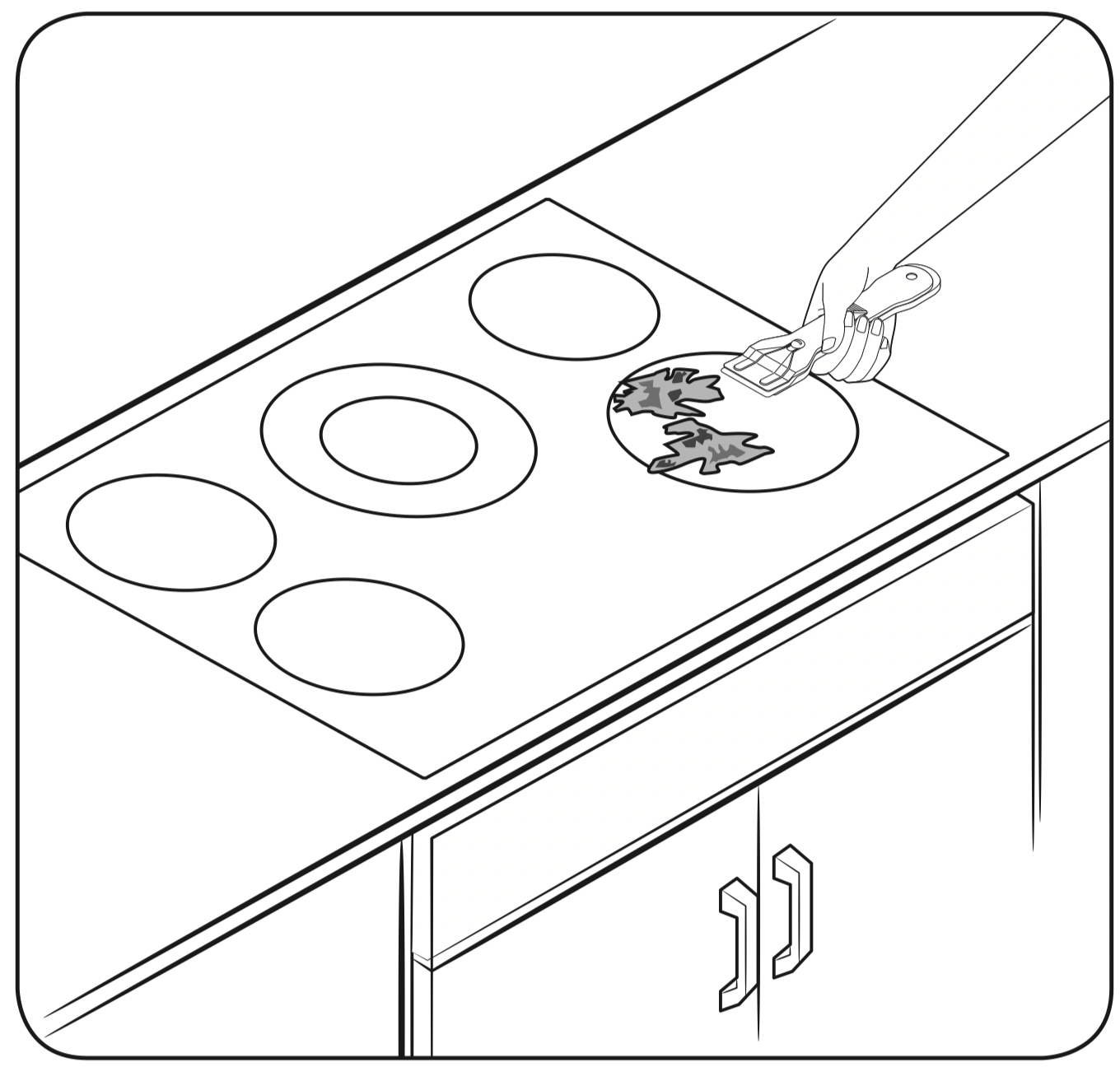
- Allow the cooktop to cool.
- Use a single-edge razor-blade scraper at approximately a 45° angle against the glass surface and scrape the soil. It will be necessary to apply pressure to remove the residue.
- After scraping with the razor scraper, spread a few drops of ceramic cooktop cleaner on the entire burned residue area. Use a cleaning pad to remove any remaining residue. (Do not scrape the seal around the edges of the cooktop.)
- For additional protection, after all residue has been removed, polish the entire surface by applying ceramic cooktop cleaner with a paper towel.
Removing metal marks and scratches
- Be careful not to slide pots and pans across your cooktop. It will leave marks on the cooktop surface. You can remove these marks by applying ceramic cooktop cleaner with a cleaning pad for ceramic cooktops.
- If pots with a thin overlay of aluminum or copper are allowed to boil dry, the overlay may leave black discoloration on the cooktop. You should remove this discoloration immediately or it may become permanent.
WARNING: Carefully check the bottoms of pans for roughness that may scratch the cooktop.
Cleaning the cooktop seal
To clean the seal around the edges of the glass, lay a wet cloth on it for a few minutes, then wipe clean with a nonabrasive cleaner.

Potential for permanent damage to the glass surface
- Sugary spillovers (such as jellies, fudge, candy, syrups) or melted plastics can cause pitting of the surface of your cooktop. This is not covered under the warranty. You should clean the spill while it is still hot. Take special care when removing hot substances. Refer to the section below.
- When using a scraper, be sure it is new and the razor blade is still sharp. Do not use a dull or nicked blade.
Cleaning sugary spills and melted plastic
- Turn off all surface units. Remove hot pans.
- Wearing an oven mitt, use a single-edge razor-blade scraper to move the spill to a cool area of the cooktop. Remove the spill with paper towels.
- Any remaining spillover should be left until the surface of the cooktop has cooled.
- Don’t use the surface units again until all of the residue has been completely removed.
NOTE: If pitting or indentations in the glass surface have already occurred, the cooktop glass will have to be replaced. In this case, service will be necessary.
Troubleshooting
Samsung works hard to ensure that you don’t have problems with your new cooktop. If you run into unexpected trouble, look first for a solution in the tables below. If you’re still having trouble after trying the suggested solution, call Samsung at 1-800-SAMSUNG (1-800-726-7864).
|
Problem |
Possible cause | Solution |
|---|---|---|
|
The surface units will not maintaina rolling boil or will not cook fast enough. |
You may be using in appropriate cookware. |
Use pans which are flat and match the diameter of the surface unit selected. |
|
In some areas, the power(voltage) may be low. |
Cover the pan with a lid until the desired heat is obtained. |
|
|
The surface units will not turn on. |
A fuse in your home may be blown or a circuit breaker may have tripped. |
Replace the fuse or reset the circuit breaker. |
|
The cooktop controls are set improperly. |
Check if the correct control is set for the surface unit you are using. |
|
|
Areas of discoloration on the cooktop. |
Food spillover was not cleaned. |
Refer to the section on the care and cleaning of the glass cooktop on page 21. |
|
The surface is hot and the model features a light-colored cooktop. |
This is normal. The surface may appear discolored when it is hot. This is temporary and will disappearas the glass cools. |
|
|
The surface unit frequently cycles on and off. |
The element will cycle on and off to maintain the power setting. |
This is normal operation, and not a system failure. Cycling at the high power setting is normal and can occur if the cookware is too small for the cooktop element or if the cookware bottom is not flat. Use the cooktop as usual. |
|
The surface unit stops glowing when changed to a lower setting. |
This is normal. The unit is still on and hot. |
|
|
Scratches or abrasions on the cooktop surface. |
The cooktop is being cleaned improperly. |
Scratches are not removable. Tiny scratches will become less visible in time as a result of cleaning. Use ceramic glass top cleaning cream. Do not use chemical or corrosive agents. These agents may damage the surface of the product. |
|
Cookware with rough bottoms was used on the cooktop or there were coarse particles (eg. salt or sand) present between the cookware and the surface of the cooktop. |
To avoid scratches, follow the recommended cleaning procedures. Make sure cookware bottoms are clean before use, and use cookware with smooth bottoms. |
|
|
Cookware has been slid across the cooktop surface. |
||
|
Brown streaks orspecks. |
Boil overs have been cooked on to the surface. |
|
|
Areas of discoloration with metallic sheen. |
Mineral deposits from water and food have been left on the surface of the cooktop. |
|
|
Cracking or "popping" sound. |
This is the sound of the metal heating and cooling during cooking. |
This is normal operation and not a system failure. Use the cooktop as usual. |





